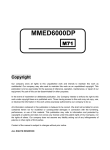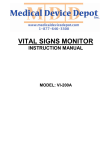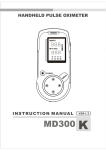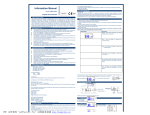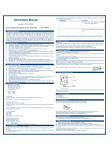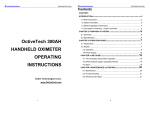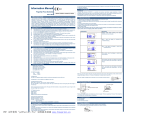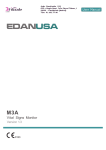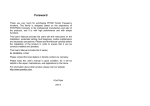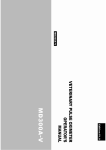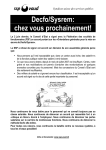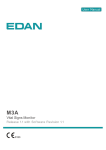Download VPOD ViTAL Owner`s Manual
Transcript
Copyright Our company owns all right to this unpublished work and intends to maintain this work as confidential. We may also seek to maintain this work as an unpublished copyright. This publication is to be used solely for the purpose of reference, operation, maintenance, or repair of our equipment. No part of this can be disseminated for other purposes. In the event of inadvertent or deliberate publication, we intend to enforce its right to this work under copyright laws as a published work. Those having access to this work may not copy, use, or disclose the information in this work unless expressly authorized by our company to do so. All information contained in this publication is believed to be correct. We shall not be liable for errors contained herein nor for incidental or consequential damages in connection with the furnishing, performance, or use of this material. This publication may refer to information and protected by copyrights or patents and does not convey any license under the patent rights of our company, nor the rights of others. We do not assume any liability arising out of any infringements of patents or other rights of third parties. The illustrations used in this manual may differ slightly from the appearance of the actual product. Content of the manual is subject to changes without prior notice. ALL RIGHTS RESERVED Version: Ver5.0 Revised date: December 22, 2014 VPOD Vital Monitor Manual CE0123 ▒▓ Monitor Series CONTENT CHAPTER 1 Introduction .............................................................................................................. 3 1.1 About the Manual ........................................................................................................................ 3 1.2 Contraindications ....................................................................................................................... 3 1.3 Safety Information ...................................................................................................................... 3 1.4 Explanation of Symbols ............................................................................................................. 5 1.5 Description of Abbreviation ....................................................................................................... 6 1.6 Intended Use................................................................................................................................ 6 CHAPTER 2 Overview Of Monitor ................................................................................................ 7 2.1 Special Feature............................................................................................................................ 7 2.2 Appearance of Monitor ............................................................................................................... 7 2.2.1 Front panel and displaying........................................................................................................... 7 2.2.2 Rear panel ...................................................................................................................................... 9 2.2.3 Battery installation ......................................................................................................................... 9 2.2.4 Grounding wire connection ........................................................................................................ 10 2.2.5 Printer (Optional) ......................................................................................................................... 11 2.3 Specification .............................................................................................................................. 12 CHAPTER 3 Patient Safety ......................................................................................................... 13 3.1 Environment .............................................................................................................................. 13 3.2 Condensation ............................................................................................................................ 14 3.3 Grounding .................................................................................................................................. 14 CHAPTER 4 Getting Started ....................................................................................................... 14 4.1 Unpacking and Inspection ....................................................................................................... 14 4.2 Connect the Power Cables ...................................................................................................... 14 4.3 Power on the Monitor ............................................................................................................... 15 4.4 Connecting Patient Sensors .................................................................................................... 15 4.5 Check the recorder ................................................................................................................... 15 CHAPTER 5 Date & Time, ID Setting.......................................................................................... 16 CHAPTER 6 Take a Measurement .............................................................................................. 18 CHAPTER 7 Data Management .................................................................................................. 20 CHAPTER 8 Alarm Set ................................................................................................................ 22 8.1 Alarm priority............................................................................................................................. 22 8.2 Alarm setting ............................................................................................................................. 22 CHAPTER 9 Print Manage .......................................................................................................... 23 CHAPTER 10 Net Connection (optional) ................................................................................... 24 CHAPTER 11 System Settings ................................................................................................... 25 CHAPTER 12 System information.............................................................................................. 27 CHAPTER 13 Data Transmition (optional)................................................................................. 27 CHAPTER 14 Trouble shooting.................................................................................................. 28 CHAPTER 15 MAINTENANCE AND CLEANING ........................................................................ 29 15.1 Maintenance ............................................................................................................................ 29 15.2 Warranty and Repair ............................................................................................................... 30 Appendix ..................................................................................................................................... 32 - 2 - VPOD Vital Monitor Manual CE0123 ▒▓ Monitor Series CHAPTER 1 Introduction 1.1 About the Manual Before using the VPOD Vital monitor, the user must carefully read this manual so that the user can operate the monitor properly and make it reach the specific safety standard and performance index. This manual explains how to set up and use the monitor. Important safety information relating to general use of the monitor appears after this introduction. Other important safety information is located throughout the text where appropriate. Note: There requires no routine calibration, safety maintenance or in-service during the monitor’s life. 1.2 Contraindications 1. Active patients. 2. Intravascular dyes such as indocyanine green or methylene blue. 3. Significant levels of dysfunctional hemoglobins (such as carbonxy- hemoglobin or methemoglobin). 4. The presence of high ambient light. Shield the sensor area( with a surgical towel, or direct sunlight, for example )if necessary. 5. Venous pulsations may cause erroneous low readings(e.g. tricuspid value regurgitation) 6. Venous congestion may cause under reading of actual arterial oxygen saturation. Therefore, assure proper venous outflow from monitored site. Sensor should be not below heart level( e.g. sensor on hand of a patient in a bed with arm dangling to the floor) 7. Avoid placing the sensor on any extremity with an arterial catheter, intravascular line or blood pressure cuff. 8. Exercise caution with poorly perfused patients; skin erosion and/or pressure necrosis may occur. 9. Do not use the monitor when the patient is in cardiac arrest or is in defibrillation. 1.3 Safety Information Warnings alert the user to potential serious outcomes, such as death, injury, or adverse events to the patient or user. Cautions alert the user to exercise care necessary for the safe and effective use of the pulse oximeter. Notes contain important information that may otherwise be overlooked or missed. Warnings 1. The monitor must be able to measure the pulse properly to obtain an accurate SpO 2 measurement. Verify that nothing is hindering the pulse measurement before replying on the SpO2 measurement. 2. Do not use the monitor in a MRI or CT environment 3. Explosion hazard: Do not use the monitor in the presence of flammable anesthetic or in an explosive atmosphere. 4. Do not make any clinical judgments based solely on the monitor. The monitor is intended only as an adjunct in patient assessment. It must be used in conjunction with clinical signs and symptoms. - 3 - VPOD Vital Monitor Manual CE0123 ▒▓ Monitor Series 5. Prolonged use or the patient’s condition may require changing the sensor site periodically. The site must be checked at least every four (4) hours to ensure adequate adhesion, circulation, skin integrity and correct optical alignment. If the circulatory condition or skin integrity is compromised, the sensor should be applied to a different site. 6. Use only SpO2 sensors provided by manufacturer for SpO2 measurements. Other SpO2 sensors may cause improper performance. 7. Use only the battery, power core provided and any accessories appointed by manufacturer, for other accessories may cause improper performance or dangerous. 8. Do not use tape to secure the sensor to the site; this can restrict blood flow and cause inaccurate readings. Use of additional tape can cause skin damage or damage the sensor. 9. Dispose of the device and its accessory according to applicable local regulations. 10. To avoid an electrical hazard, never immerse the unit in any fluid or attempt to clean it with liquid cleaning agents. Always disconnect monitor from AC Main Power before performing cleaning of maintenance. 11. If monitor becomes accidentally wet during use, discontinue operation of the monitor until all affected components have been cleaned and permitted to dry completely. Contact our local representative if additional information is required. 12. Connect the monitor to a three-wire, grounded, hospital-grade receptacle. 13. The signal output part can be only connected to the computer complying with the requirements of IEC60950. Cautions! 1. Before use the equipment, inspect whether all the cables are in good condition, the damaged cables and connectors must be replaced. Operator should examine whether the system is in correct working state and operating condition. 2. To prevent damage, do not soak or immerse the sensor in any liquid solution. 3. Do not sterilize by irradiation, steam, autoclave or ethylene oxide. 4. Operation of the monitor may be affected by the use of an electrosurgical unit (ESU). 5. The pulsations from intra-aortic balloon support can be additive to the pulse rate on the oximeter pulse rate display. Verify patient’s pulse rate against the ECG heart rate. 6. By replacing the fuse, please use the safety device of the same type and rated fuse. 7. As with all medical equipment, carefully route patient cabling to reduce the possibility of patient entanglement or strangulation. 8. To avoid monitor fall, secure monitor on the shelf or bracket prior to use. 9. If any parameters displayed on monitor and working station are not accurate, adopt the other methods to diagnosis patient. 10.The medical equipment must be manipulated by personnel who have already got relative training of operation. 10. Single-use devices should never be reused 11.The monitor may not conform to all performance specifications. If stored or used outside the environmental specifications identified in specification in the rear of this manual. 12.If the accuracy of any measurement does not seem reasonable, first check the patient’s VPOD Vitals by alternate means and then check the monitor for proper functioning. 13.Alarm must be set up according to different situation of individual patient. Make sure that audio sound can be activated when alarm occurs. 14.When an “X” appears in the Alarm Bell symbol, the audible alarm tone will not sound for any reason. - 4 - VPOD Vital Monitor Manual CE0123 ▒▓ Monitor Series 15.Do not only depend on the alarm system, the doctor and nurse will not draw attention when an alarm turn down or turn off. 16.When connecting the monitor to any instrument, verify proper operation before clinical use. Refer to the other device’s manual for full instructions. Accessory equipment connected to the monitors data interface must be certified according to IEC Standard 60601-1 for electro medical equipment. All combinations of equipment must be in compliance with IEC Standard 61601-1-1 systems requirements. To avoid potentially hazardous leakage currents, always check the summation of leakage currents when several item of equipment are interconnected. 14. For proper equipment maintenance, perform the service procedures at the recommended intervals as described in the manual. 15. If the monitor needs to be used continuously long-term, please note to connect the monitor with the main power supply by the alarm of battery, otherwise, the monitor will automatically shut down, which leads to the break-off of the monitoring. 16.Do not use the monitor during Magnetic Resonance Imaging (MRI) scanning. Induced current could potentially cause burns. The monitor may affect the MRI image, and the MRI unit may affect the accuracy of the monitor measurements. 17.Do not place the monitor in any position that might cause it to fall on the patient. Do not lift the monitor by the power supply cord or patient connections. 18.The monitor can monitor only one patient synchronously. 19.As to the other points for attention, please carefully read the relevant chapter in this instruction. 20.FEDERAL LAW (U.S.A) restricts this device to sale by or on the order of a physician. 1.4 Explanation of Symbols I Caution Class I Equipment Resistant defibrillator BF type equipment Power on/off button Alarm sound on indicator Alarm sound indicator Pulse beep sound on indicator Pulse beep sound Silence indicator The oximeter can be used as a USB device AC 50/60 HZ The NET connection is in good order The NET connection is off Alarm silence/return button Print button Down/decrease button Up/increase button Confirm button Remaining Battery power indicator Equipotential grounding terminal Fuse IPX1 European union approval Follow instruction for use - 5 - off Resistant to liquid ingress Waste electrical and electronic equipment VPOD Vital Monitor Manual CE0123 ▒▓ Monitor Series 1.5 Description of Abbreviation SPO2: PR: arterial oxygen saturation SpO2 plethysmogram pulse rate 1.6 Intended Use The VPOD Vital monitor is a portable device indicated for use in non-invasively measuring and displaying functional oxygen saturation of arterial haemoglobin (SpO 2), and pulse rate of adult and pediatric patients in hospitals, medical facilities, and subacute environments. The VPOD Vital monitor is intended for spot-checking and/or continuous monitoring of patients. - 6 - VPOD Vital Monitor Manual CE0123 ▒▓ Monitor Series CHAPTER 2 Overview Of Monitor 2.1 Special Feature Portable, compact, AC power and internal rechargeable battery Anti-high-frequency electrosurgical equipment LED & LCD display Display: SpO2,Pulse rate,Pulse bar,SpO2 plethysmogram Convenient clinic operation Up to 99 patient information and 72 hours record storage Visible &3-level audible alarm Battery-low indication Built-in rechargeable battery or AC power Built-in thermal recorder(optional) Support wired LAN (optional) USB Data upload (optional) Data storage and replay Probe suitable for adult, pediatric and neonatal 2.2 Appearance of Monitor 2.2.1 Front panel and displaying Fig. 1 Description of Fig.1: 1. LCD displaying screen: Display the SpO2 waveform, the date & time, the alarm limit, system icon and ID number. 2. Measured SpO2 % display 3. SpO2 sensor port 4. Measured pulse Rate display - 7 - VPOD Vital Monitor Manual CE0123 ▒▓ Monitor Series 5. Pulse amplitude indicator (blip bar). 6. Printing button: Press this button in measuring screen you can print the real-time records’ data and waveform. In measuring screen press the button once more you can cancel printing. 7. Down button: Press this button you can select different item and decrease the number. 8. CHG indicator: Battery charge indicator. If the battery is charging the light will flash. 9. Power switch: Press the button for 3 seconds you can turn on the monitor, or press the button for 4 seconds you can turn off the monitor. 10. Internal battery indicator: Battery power enough: The light always on Battery low: The light will be flashing. Without battery: The light will be closed. 11. UP button: Press this button you can select different item and increase the number. 12. Alarm silence button / Return button: ONLY in the measuring screen, press this button when the alarm sound is on, you can temporarily silences the audible alarm sound for one minute press this button again you can cancel the alarm silence operation. If in the selection screen of menu, press this button you can return to the previous menu or the previous screen. 13. OK button: Press this button to confirm your selection or select the different item, refer to the following reference operation instruction for details. Fig.2 Discription of Fig.2: 1: The current time display 2: The current date display 3: Remaining battery power indicator 4: SpO2 alarm limits indication. The current SpO2 alarm limits: upper alarm: 100; low alarm: 95. 5: Audible alarm status indicator. The current status in figure 2 is “audible alarm off”. 6: Pulse beep sound status indicator. The current status in figure 2 is “Beep sound off”. 7: The oximeter can be used as a USB device 8: NET connection status indicator, the current connection status of the NET in figure 2 is in good condition. - 8 - VPOD Vital Monitor Manual CE0123 ▒▓ Monitor Series 9: ID number indication: The current ID number is 1. 10: PR alarm limits indication. The current PR alarm limits: upper alarm: 120; Lower alarm: 50. 11:SpO2 plethysmogram. 2.2.2 Rear panel Fig. 3 Description of Fig.3: 1 USB Interface: The monitor can be used as the USB device. 2 NET: The NET socket connecting with the center monitor system of our company. 3 DVI: Programming interface. 4 Speaker 5 Power socket: AC Power supply socket. 6 Ground terminal 2.2.3 Battery installation Fig.4 Description of figure 4: 1— Fixing hole of fixing screw for fixing battery cover. 2,3,4,5—Electrodes for battery. 6—Battery cover. - 9 - VPOD Vital Monitor Manual CE0123 ▒▓ Monitor Series Unscrew the fixing screw in the battery cover of the oximeter bottom panel, open the battery cover, and then place the battery in to the battery box with the polarity correctly. The battery is shown in the fig.5. Make sure that the poles of the battery are playing as the following position: 2 to 2’, 3 to 3’;4 to 4’, 5 to 5’. Fig. 5 Note: Make sure that the polarity of the batteries is correct. Otherwise the unit cannot operate normally. If the monitor is not used for long time, please charge and discharge the Ni-HM battery thoroughly once a month. Warning! Do not use the battery not appointed by our company. 2.2.4 Grounding wire connection Connect the oximeter and the ground system with grounding wire (refer to Fig.6), as the following steps: Firstly, plug the socket 1 to the oximeter’s grounding terminal as Fig.7 shown. Fig.6 Fig.7 Fig.8 Secondly, press the clap on the other terminal of the grounding wire to connect with the user’s ground system. Refer to figure8 - 10 - VPOD Vital Monitor Manual CE0123 ▒▓ Monitor Series 2.2.5 Printer (Optional) The monitor can print the stored records and SpO2 waveforms if the customer selects the oximeter with TR-50 printer. Fig.9 Description of Fig.9: 1—Open button, press this button as the Icon indication, you can open the paper cassette door. 2—No paper indicator, the light will be light when there is no paper. 3—Printer power indicator, when the printer printing records the light will be light. 4—Windows for printing paper. Paper replacement Note : Record paper requirement Only standard 50(+0/-1) mm thermosensitive record paper can be used, otherwise the recorder may not function, the recording quality may be poor, and the thermosensitive printhead may be damaged. Steps for paper replacement: 1. Press the open button as the Icon indication and then pull the paper cassette door towards you until it is completely open. 2. Remove the spent paper core. 3. Place a new roll of paper into the paper cassette door with a few inches of paper being unrolled. And then push slightly the roll of paper to the paper cassette (refer to the Fig.10). Ensure proper orientation of paper roll. Fig.10 - 11 - VPOD Vital Monitor Manual CE0123 ▒▓ Monitor Series 4. Close the paper cassette door with a few inches of paper being kept outside of the door. NOTE When the recorder is working, the record paper goes out steadily. Do not pull the paper, or the recorder may be damaged. Do not operate the recorder without record paper. Make sure that the paper surface with the heat sensitive material towards to the heat sensitive printing head. 2.3 Specification Power supply Mains power Internal power Rated input current Rated power input Fuse (51F) 100-230V AC 7.2V DC 75mA Less than 25VA 250V Imax 1 A Environment The operation environment should comply with the following conditions: Operating Temperature: 5℃ to 40℃ Relative Humidity: ≤ 80%, non-condensing Standard Atmosphere Pressure : 86kPa~106kPa The transport and storage environment should comply with the following conditions: Storage Temperature: -20℃ to 55℃ Relative Humidity: 0 to 93%, non-condensing Standard Atmosphere Pressure : 50kPa~106kPa Display Type: LCD & LED Displayed Parameters Time: Alarms: Pulse & SpO2 Spo2 Display range Accuracy LED Specifications Alarm delay Display Update Resolution Battery-backed quartz crystal clock High and low limits selectable on patient parameters Pulse Rate, SpO2 plethysmograph, and percent saturation. 0 to 100% 80-100%:±2%; 70-79%±3%;0-69% Unspecified Wavelength Radiant Power 660±3nm RED 1.8mW 940±10nm IR 2.0mW SpO2 high and low limits alarm delay<7s <5s 1% - 12 - VPOD Vital Monitor Manual CE0123 ▒▓ Monitor Series Pulse Rate Measurement Range Resolution Accuracy Alarm delay 30 to 235bpm 1bpm 30-100, ±2bpm; 101-235±2%;0-29 Unspecified Pulse rate high and low limits alarm delay<7s Alarm Setting Range SpO2(rpm) PR (bpm) Upper alarm range 71-100 31-235 Low alarm range 70-99 30-234 Parameter Classifications Protection Class Protection against moisture Type BF defibrillation proof IPX1 CHAPTER 3 Patient Safety The VPOD Vital monitor is designed to comply with the International Safety requirements for medical electrical equipment. This device has floating inputs and is protected against the effects of defibrillation and electrosurgery. If the correct electrodes and ECG cable are used and applied in accordance with the manufacturer instructions, the screen display will recover within 10 seconds after defibrillation. 3.1 Environment Follow the instructions below to ensure a completely safe electrical installation. The environment where the monitor Portable Monitor will be used should be reasonably free from vibration, dust, corrosive or explosive gases, extremes of temperature, humidity, and so on. For a cabinet mounted installation, allow sufficient room at the front for operation and sufficient room at the rear for servicing with the cabinet access door open. The Monitor operates within specifications at ambient temperatures between 0℃ and 40℃. Ambient temperatures that exceed these limits could affect the accuracy of the instrument and cause damage to the modules and circuits. Allow at least 2 inches (5cms) space around the instrument for proper air circulation. - 13 - VPOD Vital Monitor Manual CE0123 ▒▓ Monitor Series 3.2 Condensation Make sure that during operation, the instrument is free of condensation. Condensation can form when equipment is moved from one building to another, thus being exposed to moisture and differences in temperature. 3.3 Grounding To protect the patient and hospital personnel, the cabinet of The Portable Monitor must be grounded. Accordingly, The Portable Monitor is equipped with a detachable 3-wire cable which grounds the instrument to the power line ground (protective earth) when plugged into an appropriate 3-wire receptacle. If a 3-wire receptacle is not available, consult the hospital electrician. If the capacity of the protective grounding wires is in doubt, the equipment must be operated with internal power supply. CHAPTER 4 Getting Started NOTE To ensure that the monitor works properly, please read Chapter 3, and follow the steps before using the monitor. 4.1 Unpacking and Inspection Open the package and take out the monitor and accessories carefully. Keep the package for possible future transportation or storage. Check the components according to the packing list. Check for any mechanical damage. Check all the cables, modules and accessories. If there is any problem, contact the distributor immediately. 4.2 Connect the Power Cables Connection procedure of the AC power line: Make sure the AC power supply complies with following specification: 100-230 (VAC), 50/60 (Hz). Ensure that the AC outlet is properly grounded. ⑴ Apply the power line provided with the monitor. Plug the power line into the power socket on the rear panel. ⑵ Connect the other end of the power line to a grounded 3-line power output. NOTE Connect the power line to the jack special for hospital usage. The battery needs to be charged after transportation or storage. If the power supply is not properly connected before turning on the monitor, it may not work properly because of insufficient power. Connect the mains power supply to charge the battery. - 14 - VPOD Vital Monitor Manual CE0123 ▒▓ Monitor Series 4.3 Power on the Monitor After the oximeter sensor is connected to its input cables, turn the monitor on by momentary pressure on the front-panel POWER button (on the front panel) for 3 seconds. Audible feedback after pressing, the monitor initiates monitoring operation. NOTE Check all the functions that may be used to monitor and make sure that the monitor is in good status. The battery must be recharged to the full electricity after the battery low indicator appears. Suggest recharging the battery to the full electricity after each use of monitoring so as to reserve sufficient power in battery. WARNING If any sign of damage is detected, or the monitor’s display some error message, do not use it on any patient. Contact the biomedical engineer in the hospital or the distributor immediately. 4.4 Connecting Patient Sensors Connect oximeter sensors to the monitor (refer to Fig.15 of chapter 6). NOTE For information on correct connection, refer to related Chapter. 4.5 Check the recorder If your monitor is equipped with a recorder, open the recorder door to check if paper is properly installed in the output slot. If no papers present, do not press “PRINT” function button. - 15 - VPOD Vital Monitor Manual CE0123 ▒▓ Monitor Series CHAPTER 5 Date & Time, ID Setting The Portable Monitor features flexible configurations. You can configure various aspects of the monitor, including TIME, PRINTER, backlight, ID number, and so on. 5.1 Main menu Press the power on button for about three seconds to turn the monitor on, and then press the button to enter into the main menu and press the button to look through the items. Refer to Fig11 (1) and the Fig.11 (2). Fig.11 (1) Fig.11 (2) Description of main menu: 1 . : By this menu you can review the measuring data and the SpO2 trend, PR trend. 2. : By this menu you can set the alarm mode, alarm limit. 3. : By this menu you can set the parameters for print. 4. number. : By this menu you can set the net on or off and the patient bed 5. :By this menu you can set the Date and Time, patient ID, pulse beep and alarm sound volume and so on. 6. : By this menu you can set the system information such as: Date and Time, Patient ID, back light, beep sound, alarm volume. 7. : By selecting and confirming this selection, you can return to the measuring screen. 5.2 Time and the ID number setting Always set the date and time before using the unit for the first time. Set different ID number for different user. Check whether the date and time are correct before using the unit, reset them if necessary. The date and time are important indicators when a measurement is taken. - 16 - VPOD Vital Monitor Manual CE0123 ▒▓ Monitor Series 5.2.1 Time setting: After power on the monitor, and press the button to select “System Settings” and press button to confirm your selection, you will see the following picture. Fig.12(1) Fig.12(2) Select the “Date and time” item and press the button to confirm your selection. And then you will enter into the “Date and time” setting menu. (Refer to Fig.13). Fig.13 Press the button to select the different data item, and press the or button to set the increase or decrease the data. And then press the button to return to the previous screen. The setting ranges of the date and time are as follows: Year: 2000-2020 Month: 1-12 Day: 1-31 Hour: 0-23 Minute: 0-59 Second: 0-59 5.2.1 ID number setting: Press the button to select the “Patient ID Set” item and then press the button to confirm your selection (refer to the Fig.14). Fig.14 Press the or button to set the suitable ID number. And then press the return to the previous screen. The setting range of the ID number is 1~99. - 17 - button to VPOD Vital Monitor Manual CE0123 ▒▓ Monitor Series CHAPTER 6 Take a Measurement After the time and the ID number setting, finish the sensor connection and measurement according to the following pictures: Firstly, connect the sensor with the monitor; secondly, select the suitable sensor in terms of type and dimension. Clip the sensor to the rational position of the patient finger NOTE: The sensor Latex Free. No toxicity, which meet biology compatibility request. Fig.15 Fig.16 Measurement performance in low perfusion condition: The measured value’s accuracy is according with the requirements of ISO9919 when the low perfusion ratio is 0.5%. Displayed data: The displayed data is the average value of four measured data. Data update period: The data update period is four seconds, Signal inadequate indicator When the signal is inadequate the monitor will display “SEN OFF” or “–” in the LED display screen. When the signal is inadequate the PR and the SpO2 values will be displayed temporarily and then the LED screen display the “SEN OFF” or “–” Warning! DO not read the values during the signal inadequate indicator. Warnings! A function tester cannot be used to assess the accuracy of a pulse oximeter probe or a pulse oximeter monitor. The measurement would not be performed if the following instances come across in operation: - 18 - VPOD Vital Monitor Manual CE0123 ▒▓ Monitor Series Shock Low temperature of hand Have taken vascular activity medicine Anemia carboxyhemoglobin methemoglobin methylene blue Indigo carmine Use only SpO2 sensors provided by manufacturers for SpO2 measurements. Other SpO2 sensors may cause improper performance. Do not use a SpO2 sensor with exposed optical components. Excessive patient movement may cause inaccurate measurements. Tissue damage can be caused by incorrect application or use of sensor, for example by wrapping the sensor too tightly. Inspect the sensor site to ensure skin integrity and correct positioning and adhesion of the sensor. More frequent inspection should be taken depend on different patients if necessary. Set the upper limit of SpO2 alarm to 100% means cut off the upper alarm. High density of oxygen will cause adverse affection to the neonate .So the upper limit of SpO2 alarm must be selected prudently according to the acknowledge clinical practice. Inaccurate measurements may be caused by: Incorrect sensor application or use Significant levels of dysfunctional hemoglobins (such as carboxyhemoglobin or methemoglobin) Intravascular dyes such as indocyanine green or methylene blue Exposure to excessive illumination, such as surgical lamps (especially ones with a xenon light source), bilirubin lamps, fluorescent lights, infrared heating lamps or direct sunlight High-frequency electro surgical interference and defibrillators Venous pulsations Placement of a sensor on an extremity with a blood pressure cuff, arterial catheter, or intravascular line The patient has hypotension, severe vasoconstriction, severe anemia, or hypothermia There is arterial occlusion proximal to the sensor The patient is in cardiac arrest or in shock Loss of pulse signal can occur in any of the following situations: The sensor is too tight There is excessive illumination from light sources such as the surgical lamp, abilirubin lamp, or sunlight A blood pressure cuff is inflated on the same extremity as the one to which an SpO2 sensor is attached Note! Pulse sensor should obviate the light source, e.g. radial lamp or infrared lamp. The measured record is stored automatically every four seconds. The monitor can store 72 hours records. The new record will be stored with the initial records being erased when the stored records are full. - 19 - VPOD Vital Monitor Manual CE0123 ▒▓ Monitor Series CHAPTER 7 Data Management The monitor contains an internal memory that can store 72 hours data records. You can review, print or erase data records. If the data are cleared, they are not available to print. In the main menu screen, press the or the button to select the “Data Management” item, and then press the button to enter into the sub menu, you can review measured data records, SpO2 trend and PR trend. You can also erase data in this menu. Refer to the following pictures. Fig.17 7.1 Fig.18 Record Review By selecting this menu as shown in Fig.18 you can review the measurement records (refer to Fig.19), press the or the button to review the records page by page, the longer you press the or button the faster record page changes. Press the button to return to the previous menu. Fig.19 Description of Fig19: 1.—42/47: Means that there are 47 pages SpO2 trend chart, the current page is the 42nd. 2,3—Date, Time: The date and time of the measured PR and SpO2 record. 4—PR: The area of PR displaying. 5—ID: The record ID displaying area. 6—SpO2: The measured SpO2 data displaying area. 7— Pageup. 8— Pagedown. - 20 - VPOD Vital Monitor Manual CE0123 ▒▓ Monitor Series 7.2 SpO2 Trend review You can review the trend of measured SpO2 data. Press the button to select the “SpO2 Trend review” item and then press the to enter into the SpO2 Trend review screen (refer to Fig.21). Press the or down or page up. Press the button to return to the previous screen. Fig.20 button to page Fig.21 Note: Every trend chart can only display 12 minutes SpO2 measured data. 7.3 PR Trend review Press the button to select the “PR Trend review” item and then press the button to enter into the PR Trend review screen (refer to Fig.23). Press the or button to turn page down or page up. Press the button to return to the previous screen. Fig.22 7.4 Fig.23 Erase All Data Press the button to select the “Erase All Data” item and then press the button to enter into the Empty Log review screen (refer to Fig.24(1),(2)). Press the or to select “Yes “or “No” to delete records or not. Press the button to return to the previous screen. Fig.24 (1) Fig.24 (2) - 21 - VPOD Vital Monitor Manual CE0123 ▒▓ Monitor Series CHAPTER 8 Alarm Set 8.1 Alarm priority There are there-level priorities for selection. High priority: the highest level alarm, indicate the patient is in the very dangerous situation. Medium priority: indicate the warning should be paid attention. Low priority: indicate the finger off or finger sensor off. Alarm of this oximeter includes technical and physiological alarm. All three priorities divided by built-in module and can not be changed by user. VISUAL ALARM INDICATORS: If the alarm is activated through over limitation of physiological alarm, corresponding data will be flashing. If the alarm is activated by more than one physiological alarm, each parameter will be displayed with flashing. AUDIBLE ALARM INDICATORS: Audible alarms can be heard if there is no silence. The audible alarm has different tone pitch and on-off beep patterns for each alarm priority. High priority: "du-du-du-------------du-du”, beeps every 8 seconds. Medium priority: "du-du-du", beeps every 5 seconds. Low priority: "du-”, beeps every 5 seconds. Assignment of priority: SpO2: High priority PR and battery low: Medium priority Other information: low priority 8.2 Alarm setting In the main menu screen, press the or the button to select the “Alarm Set” item, and then press the button to enter into the sub menu. Refer to the Fig.25. Fig.25 Press the button to select different alarm limit to set up. And then press the or to increase or decrease the alarm value. Press the button to return to the previous menu. Alarm limits setting range: SpO2: Upper alarm range: 71-100 The default SpO2 upper alarm is 100. Low alarm range: 70-99 The default SpO2 low alarm is 95. PR: Upper alarm range: 31-235 The default PR upper alarm is120. Low alarm range: 30-234 The default PR low alarm is 50. Alarm sound: ON or Off Note: When the oximeter is turned off, the alarm limits of the last time set are restored, when the oximeter is turned on, you should set alarm limits again if necessary. - 22 - VPOD Vital Monitor Manual CE0123 ▒▓ Monitor Series CHAPTER 9 Print Manage The monitor can print data when used with a TR50 printer. In the main menu screen, press the or the button to select the “Print Manage” item, and then press the button to enter into the sub menu. Refer to the Fig.26 . Fig.26 Press the button to select different item to set up. And then press the or button to set the print mode or change value of different items. Press the button to return to the previous menu. Print mode: There are two print modes for selection. Record & Wave: If you select this printing mode, when you press the button in the measuring screen, the printer firstly print the real-time data records and then print the real-time waveforms. Refer to Fig.27. Fig .27 Record Only: when you select this printing mode, the printer will print the data records only. Refer to Fig.28. Fig.28 Wave/Page: You can set the waveform’s length of per printing page. The setting range is: 5s-30s. Items/Page: You can set that how many records are printed in one printing page. The setting range is from 10 to 255. Interval: You can select the printing interval by this item. The setting range is from 4s to 60s. - 23 - VPOD Vital Monitor Manual CE0123 ▒▓ Monitor Series CHAPTER 10 Net Connection (optional) The monitor can connect with our central monitoring systems. If the customer select the Net function. In the main menu screen, press the or the button to select the “Net Connect” item, and then press the button to enter into the sub menu. Refer to the Fig.29 . Fig.29 Net connect setting: Press the button to select different item to set up. And then press the or button to set the net connect on or off. ON: The net connection is on. Off: The net connection is off. Press the button to return to the previous menu. Bed No. settings: Press the button to select the “Bed No.” item, and then press the or button to change the bed number. Press the button to return to the previous menu. The setting range of the Bed number is 1 to 99. - 24 - VPOD Vital Monitor Manual CE0123 ▒▓ Monitor Series CHAPTER 11 System Settings In the main menu screen, press the or the button to select the “System Settings” item, and then press the button to enter into the sub menu. Refer to the following picture. Fig.30 11.1 Date& time, ID number setting Please refer to the “5.2 Date & Time, ID number setting” for the time and the ID number setting. Fig.31 Fig.32 11.2 Backlight set In the system setting menu press the or the button to select the backlight item and press the button to enter into the sub menu (refer to Fig.33). Fig.33 button to select the item, and then press the or button to change the number or the backlight mode. Press the button to return to the previous screen. The backlight brightness level: 0-9 and for selection. Backlight mode: 0-10 minutes and “Always ON” for selection. Press the - 25 - VPOD Vital Monitor Manual CE0123 ▒▓ Monitor Series 11.3 Pulse Beep Set In the system setting menu press the or the button to select the “Pulse Beep Set” item and press the button to enter into the sub menu (refer to Fig.34). Fig.34 Press the button to select different item to set up. And then press the or to set the print mode or change the value of different items. Press the button to return to the previous menu. Beep mode: ON or OFF Beep volume: 1-8 11.4 Alarm Volume Set In the system setting menu press the or the button to select the “Alarm Volume Set” item and press the button to enter into the sub menu (refer to Fig.35). Fig.35 Press the or the button to set the print mode or change value of different items. Press the button to return to the previous menu. Alarm volume: 1-8 11.5 Language Set & USB Mode Set These two functions are reserved. (“Languages Set” Offering according to the custom’s order). Fig.36 11.6 Return After finish the system settings, you can select the return item and press the return to the previous menu. - 26 - button to VPOD Vital Monitor Manual CE0123 ▒▓ Monitor Series CHAPTER 12 System information In the main menu screen, press the or the button to select the “System info” item, and then press the button to confirm your selection. And then press the button again to exit the current menu. By this menu you can look through the system’s software version and the software distribution date shown as the Fig.37 Fig.37 Note: The information will change when the software update without prior notice. CHAPTER 13 Data Transmition (optional) This function is optional. Please refer to the software instruction manual for the specifications of data transmition. - 27 - VPOD Vital Monitor Manual CE0123 ▒▓ Monitor Series CHAPTER 14 Trouble shooting Problems SpO2% or pulse rate can not be shown normally SpO2% or pulse rate is shown unstably Possible reason Solution 1.Retry by plugging the finger 2. There is excessive illumination 1.Finger is not plugged 3. Measure more times, If you correctly can make sure about no problem 2. Patient’s SpO2value is too existing in the product. Please go low to be measured to a hospital timely for exact diagnosis 1. Finger may not be plugged deep enough 1. Retry by plugging the finger 2.Excessive patient 2. Be calmness. movement 1.No battery or low power of 1. Please replace battery battery 2. Please reinstall the battery The Monitor can 2.Battery might be installed 3. Please contact with local not be powered on incorrectly customer service center 3. The Monitor might be damaged 1.CSN604 Displaying screen damaged can not be 2. Hang refreshed Data failure SpO2 module 1. Contact with local customer service center 2. Re-power on (cut off the AC power and fetch out DC battery ) storage 1. The ID number is zero 2. The memory is damaged 1. Set the ID number in range of “1~99” 2. Please contact with the local customer service center Printing failure 1. Low power 2. Wrong operation 1. Please change the battery or adopt the AC power supply 2. Please refer to the instruction manual for printing. Net connection 1. The net connect mode is 1 Please set the net connect failure off in the “Net connect “menu. mode as “ON” 2. Wrong connection of the 2 Re-connect the cable or change network cable or cable another cable. connection badness. - 28 - VPOD Vital Monitor Manual CE0123 ▒▓ Monitor Series CHAPTER 15 MAINTENANCE AND CLEANING 15.1 Maintenance Customers should be responsible for periodic maintaining of the product and its accessories. It is very important for our company to warrant the service and repairs. We reserve the rights to change the time limit of warranty and replacement if the following steps are non-implemented: ⑴An effective maintenance plan should be designed for the product and its reusable accessories. It includes periodic inspections and cleaning. It should be accord with the policy of local infection control department or health institution. ⑵Be sure to disconnect power line from the product before cleaning and inspecting. ⑶Periodic cleaning (accordance with the policy of local infection control department or health institution). Dampen a cloth with a commercial, nonabrasive cleaner and wipe the tip, bottom, and front surfaces lightly. The following admissive liquor can be used: ● Ammonia (diluted), ● Glutaraldehyde, ● Sodium hypochlorite bleacher (diluted) ● Mildness suds (diluted). Please obey the following rules to prevent from damaging the product: ● Always use diluted liquor recommend by the manufacture. ● Always wipe up cleaning liquor after cleaning. ● Never use cleaning matter containing wax. ● Never spray water or cleaning liquor over the product, or allows any liquid to flow into power switcher, connector, or other intake. ● Never use the following cleanser: ○ any kinds of abrasive cleaner and menstruum ○ acetone ○ ketone ○ spirituous cleanser ○ lycine. ● In order to clean display, please use clean flexible cloth and make it wet with cleanser in the glass. Never spray cleanser in the glass on the screen, or use alcohol or medical disinfector, such as glutaraldehyde or lycine. ● Please use warm wet cloth and mildness suds to clean cables and lead wires. Other cleaning ways may reduce the life of cables and lead wires. Recommendation: ● Do not power on/off frequently. - 29 - VPOD Vital Monitor Manual CE0123 ▒▓ Monitor Series ● Take down and safekeeping probes, lead wires, gluey tube after using product. ● Please hold the product in package if the product would not work for a long time. ● Do not make the product contact with chemical medicine and reagent. ● Battery Maintenance If the monitor has not been used for a long period of time(two month also), the battery will need charging. If there is any abnormity, stop working. It can be reused after inspecting and repairing by technician. 15.2 Warranty and Repair 15.2.1 Warranty and repair content ⑴Repair response time: AM9:00 to PM17: 30 on Monday to Friday except legal holiday. Repair time: AM9:00 to PM17: 30 on Monday to Friday except legal holiday. ⑵Repair service: Including telephone support, field inspecting, fittings replacement. Telephone support: we can give guidance to customer’s engineer to inspecting the instrument when you dial our service line. Professional repair engineer online provides technical support. Field inspecting: we will send engineers to repair the instrument if necessary. Certified engineers of our company or local repair team trained by our company provide this service. Fittings replacement: if necessary, we will replace the damaged fittings according to contract. The damaged fittings should be returned to us except for special reason. ⑶ Spare machine for repair: it is used to replace the damaged machine for customer using, customer should send the damaged machine to us to repair. ⑷ Repair for sponsoring and contributing machine: customer should send the machine to us to repair. ⑸ Updating software is free. 15.2.2 Exemption and restriction: ⑴ Warranty does not apply to the damage or loss sustained due to well-known act of god, such as fire, earthquake, flood, thunder, cyclone, hail, electrical storm, blast, building collapse, commotion, etc. ⑵ Non-service items: ① The cost and insurance of dismantling and testing, overhauling, reinstall, transfer, moving the instrument or parts. ② Damage or loss sustained due to inspected or repaired by other institute that is not certified ③ Damage or alteration by anyone else who are not our company authorized service personnel. ⑶ The damage or lose sustained due to connection to peripheral equipment (such as printer, computer etc.), that are not provided by our company are not covered by the warranty. ⑷Obligation restriction: In the duration of warranty, if the operators use other fittings that are not provided by us, we reserve the right to cancel warranty. - 30 - VPOD Vital Monitor Manual CE0123 ▒▓ Monitor Series 15.2.3 Customer guarantees: ⑴ Read the user manual carefully before operation. ⑵ Operation and maintenance according to the user manual, and guarantee the requests of power and environment. 15.2.4 Non-warranty and Non-replacement Policy ● The work environment is not eligible. For example, if the relative humidity ● ● ● ● ● ● ● ● exceeds 70%, circuit boards of the instrument may be damaged due to condensate. If voltage of power supply is fluctuant and exceeds 240VAC, the power adapter may be damaged. There is smear or marks that are not belong to the instrument and cannot be removed from the outside surface of the instrument. The instrument or its fittings are mechanically damaged. The circuit is short and damaged due to liquor or other stuff flow in the instrument or its fittings. All probes and accessories are not free replacement. Leakage of air cell of blood pressure sleeve due to improper storage or operation is not free replacement. The malfunction with result form improper repair by anyone other than our company authorized service personnel. The malfunction with result from improper use. 15.2.5 Customer special warranty period We stipulate the warranty period according to the relevant electronic regulation of country, the unit’s warranty period is one year and the accessory’s is three months. When customer requires to extending the warranty period, you should consider whether it is reasonable. AS the electronic product’s quickly replacing speed, if the warranty period over three years, purchased accessories may be out of stock. In this case, we will adopt to entirely upgrade or replace the old, you should pay the minimum acceptable cost of renewed device. 15.2.6 Repackaging Remove all the detectors, leads and accessories and put them into the plastic bag. Try to use the original packaging case and materials. Any damage due to the improper packaging during the transportation shall be responsible by the user. If you are still within the period of warranty, please present the warranty card and one copy of the invoice or receipt. Please present a written note detailing all the troubles when repairing the instrument. - 31 - VPOD Vital Monitor Manual CE0123 ▒▓ Monitor Series Appendix List of Accessories The accessories list below is specified to be used in this device of our company. The user can order the various accessories according to the hospital requirements. The standard accessories: No. 1 2 3 4 5 6 7 Accessories SpO2 probe (for adult) Power cable Grounding wire Operator’s manual Battery Pack Screwdriver USB data cable Quantity 1 piece 1 piece 1 piece 1 piece 1 piece 1 piece 1 piece The optional accessories: No. 1 2 3 4 Accessories SpO2 probe (for Pediatrics, Infants, and Neonates) Thermal array recorder (including one roll paper for recorder) Data upload software Module and accessories for connection with the central station - 32 - Quantity 1 piece 1 group 1 piece 1 group
































